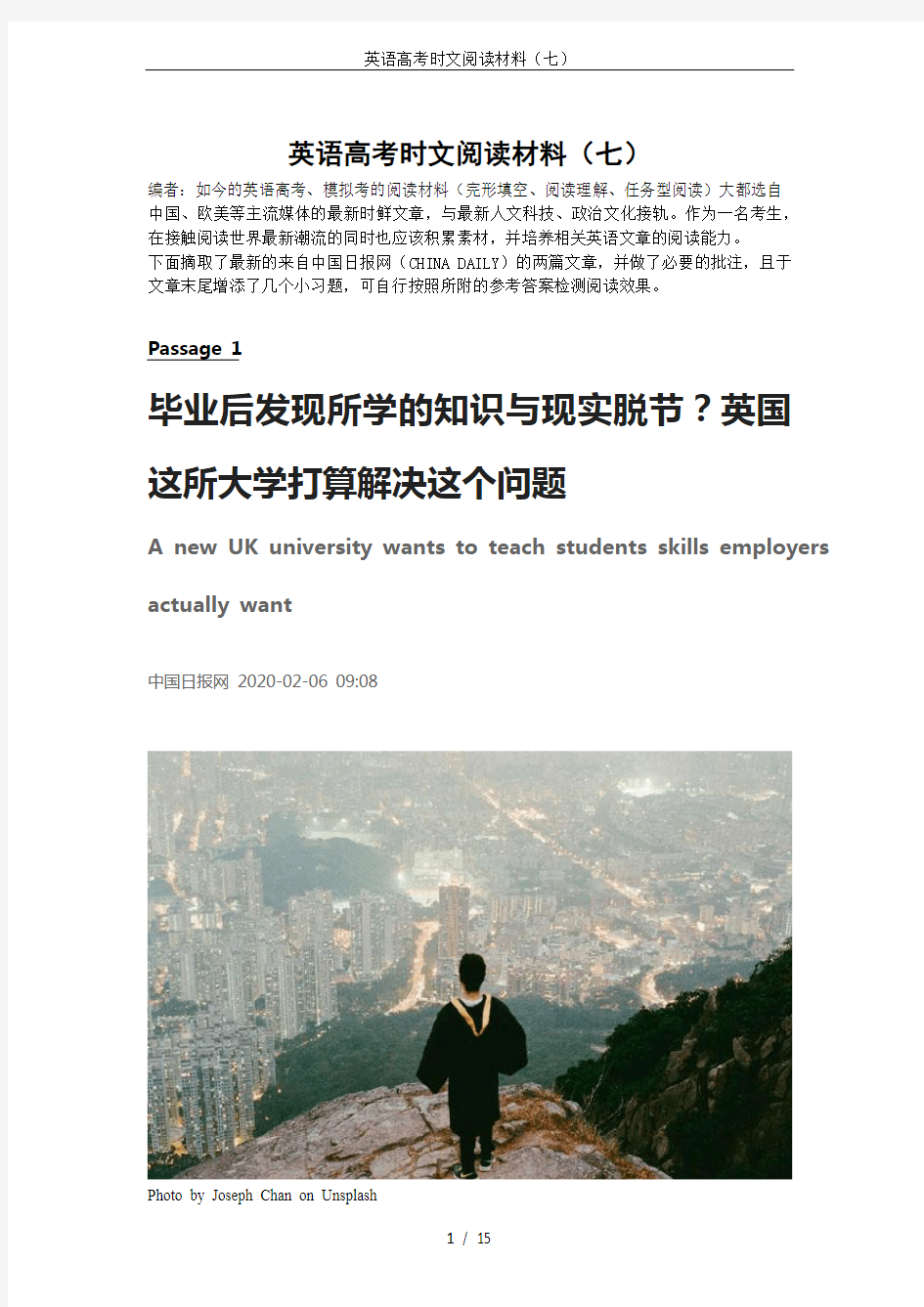英语高考时文阅读材料(七)


英语高考时文阅读材料(七)
编者:如今的英语高考、模拟考的阅读材料(完形填空、阅读理解、任务型阅读)大都选自中国、欧美等主流媒体的最新时鲜文章,与最新人文科技、政治文化接轨。作为一名考生,在接触阅读世界最新潮流的同时也应该积累素材,并培养相关英语文章的阅读能力。
下面摘取了最新的来自中国日报网(CHINA DAILY)的两篇文章,并做了必要的批注,且于文章末尾增添了几个小习题,可自行按照所附的参考答案检测阅读效果。
毕业后发现所学的知识与现实脱节?英国这所大学打算解决这个问题
A new UK university wants to teach students skills employers actually want
中国日报网2020-02-06 09:08
Photo by Joseph Chan on Unsplash
Getting a university degree has never seemed more important: college graduates earn more money, live longer, and are happier. But college degrees are expensive (especially in the US), narrowly focused (especially in the UK), and often fail to build the skills employers want (true in most countries).
A new university in the UK wants to change that.
The London Interdisciplinary School (LIS), which will launch(开展)in 2021 with a target of 100 students, will scrap(摈弃)traditional academic subjects and offer a three-year bachelor of arts and sciences degree designed to tackle real-world issues. The curriculum(课程)is built around interdisciplinary(跨学科的)problems—knife crime, childhood obesity(肥胖), palm oil(棕榈油)in supply chains, plastic pollution—as well as quantitative and qualitative research skills. Employers like the Met Police, Innocent, and Virgin will provide project ideas and offer five-week work experience for students.
The idea is similar to a US liberal arts degree (a rarity in the UK) but also more explicitly(显然地)focused on “interdisciplinarity,” or drawing on multiple(复杂的)subjects—economics, psychology, sociology, statistics—to solve complex problems like childhood obesity. In other words, the problem, not the subject, sits at the center of the curriculum. The skills students develop, the founders hope, will more closely align with what an AI-infused, automated world demands: collaboration between people and machines, critical thinking, speaking and writing skills, and data management, to name just a few things.
align[??la?n]: v. 使结盟;使成一行;匹配
Students will tackle problems through various disciplines(学科知识): knife crime, for example, by understanding cultural and socioeconomic factors in different neighborhoods, data science, statistics, publicly available data, an economics or psychology lens(角度).
In the UK, students apply through a central clearinghouse, and exam results are paramount. At LIS, students will instead apply directly and all will be
invited to a “selection day” which will include a face-to-face interview so that LIS can understand a student’s background, motivations, and passions. Interviews will be conducted by a panel to minimize bias. Conditional offers will be granted based on personal background, circumstances(情况)and, also, grades.
近视的人,老了以后视力会变好吗?
中国日报双语新闻微信2019-12-29 09:00
The answer is: it depends.
答案是:不一定。
Babies are actually farsighted(远视的), and as they grow older their eyes
grow too until they reach a point of "perfect" eyesight, called emmetropia(屈光正常).
It isn't entirely worked out what cues the eye that it is time to stop growing, but we know that in many kids the eye continues to grow past emmetropia and they become nearsighted.
Basically, when the eye grows too long the light inside the eye comes to a focus in front of the retina rather than at the retina, causing blurry vision, so we must wear glasses to change the optics and focus the light onto the retina(视网膜)again.
When we age, we suffer a different process. Our tissues become stiffer and the lens doesn't adjust as easily so we start to lose near vision as well.
Many older folks must wear bifocals which have two different lenses- one to correct for the problems with near vision and one to correct for problems with far vision.
More than half the young children and teenagers in China are nearsighted, according to a survey by top government agencies, which called for intensified(使增强)efforts to prevent and control the condition.
The survey, which was conducted last year, found that eight of 10 senior middle school students were nearsighted, compared with 71.6 percent in junior middle school, 36 percent in primary school and 14 percent of 6-year-olds in kindergarten. Overall, 53.6 percent were nearsighted.
The prevalence of a high degree of myopia also became alarming as the percentage of senior students in high school, who wear glasses stronger than six diopters, has mounted to 21.9 percent.
Up to 80 percent of the country’s young adults suffer from nearsightedness, according to a report in the medical journal Lancet. In contrast, the overall rate of myopia in the UK is about 20-30 percent.
If you walk the streets of China today, you'll quickly notice that most young people wear glasses. In Shanghai, for instance, 86 percent of high school students suffer from myopia, or nearsightedness, according to Xinhua News Agency.
The growing prevalence of myopia is not only a Chinese problem, but it is an especially East Asian one. According to a study published in The Lancet medical journal in 2012, by Ian Morgan, of the Australian National University, South Korea leads the pack, with 96 percent of young adults (below the age 20) having myopia; and the rate for Seoul is even higher. In Singapore, the figure is 82 percent.
Several factors are associated with the high rate of nearsightedness in China's children and teenagers, including lack of outdoor physical activity, lack of adequate sleep due to heavy extracurricular work and excessive use of electronics products.
Biologists compared Singaporeans living in Singapore to those living in Australia. They found that 29 percent of the Singaporean students had myopia compared with just 3 percent in Sydney. The main correlation was once again, time spent outside.
“The big dif ference was the Chinese children in Australia were outdoors a lot more than their matched peers in Singapore,” says Ian Morgan, a retired biologist at Australian National University, who coauthored the 2008 study. “This was the only thing that fit with the huge difference in prevalence.”
最后来回顾一下与视力相关的单词吧!
近视可以叫nearsightedness,也可以叫shortsightedness,医学上叫做
myopia.
同理,远视就是farsightedness,或者longsightedness,前一个偏美式,
后一个则偏英式,学术上的远视叫做hyperopia.
Notes
myopia /ma??o?pi?/ n.近视
hyperopia /ha?p??o?pi?/ n.远视
bifocals /ba??fo?klz/ n.双光眼镜(上半片为看远,下半片为看近)retina /?ret?n?/ n.视网膜
lens /lenz/ n.(眼球的)晶状体
prevalence /?prev?l?ns/ n.流行;盛行
understatement /??nd?ste?tm?nt/ n.保守说法;低调说法;轻描淡写
Translate the underlined sentence.
1.. The curriculum(课程)is built around interdisciplinary(跨学科的)
problems—knife crime, childhood obesity(肥胖), palm oil(棕榈油)in supply chains, plastic pollution—as well as quantitative and qualitative research skills.
2. The skills students develop, the founders hope, will more closely align with what an AI-infused, automated world demands: collaboration between people and machines, critical thinking, speaking and writing skills, and data management, to name just a few things.
Answer key:
1.以解决现实世界的问题为目标,围绕持刀犯罪、儿童肥胖、棕榈油供
应链、塑料污染等跨学科问题以及定量和定性研究技能来设置课程。
2.创办者希望,学生们发展的技能——人和机器的协作、批判性的思考、说话和写作技能、数据管理等等——将能和一个充斥着人工智能的自动化世界的需求接轨。
